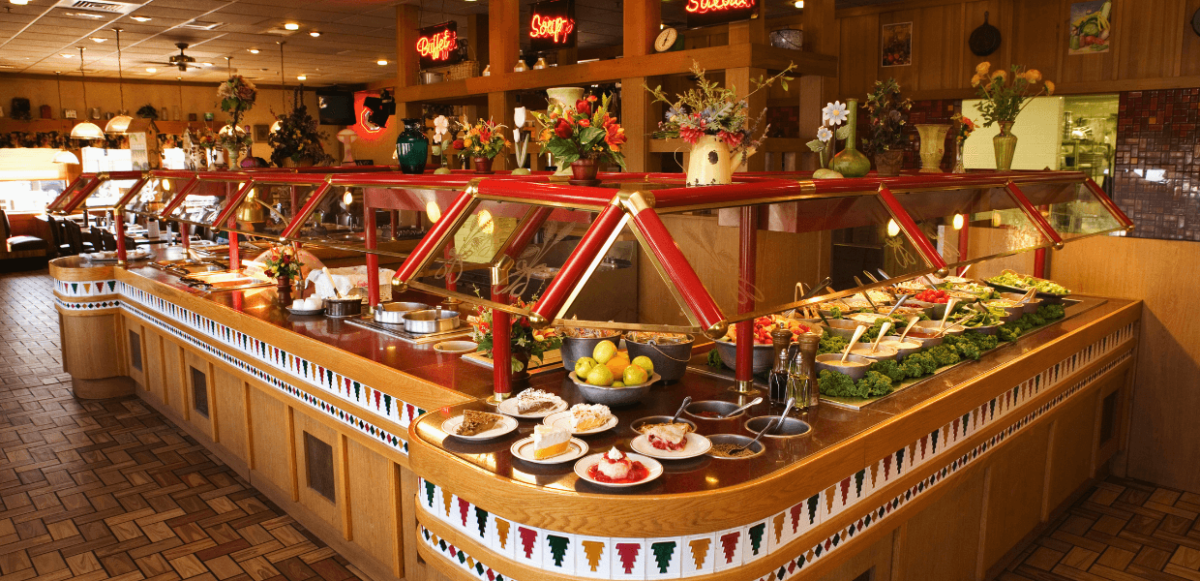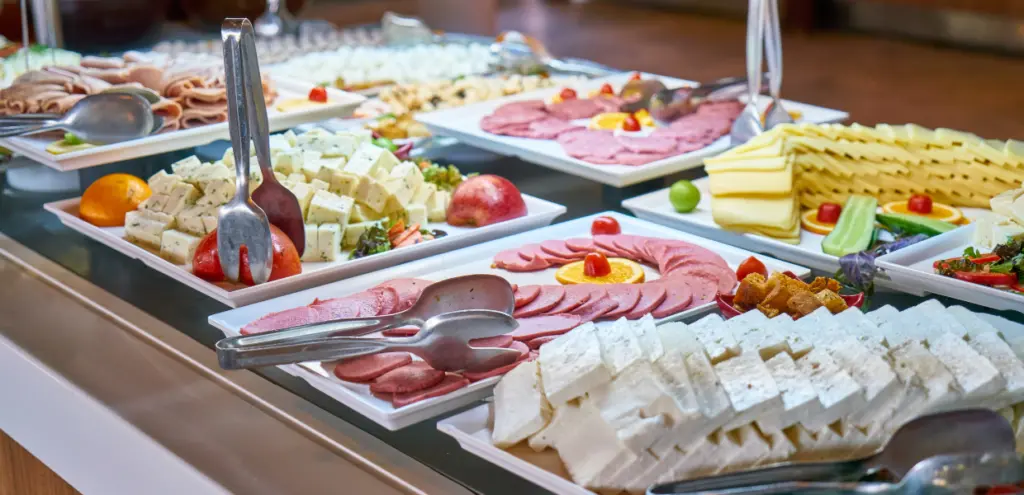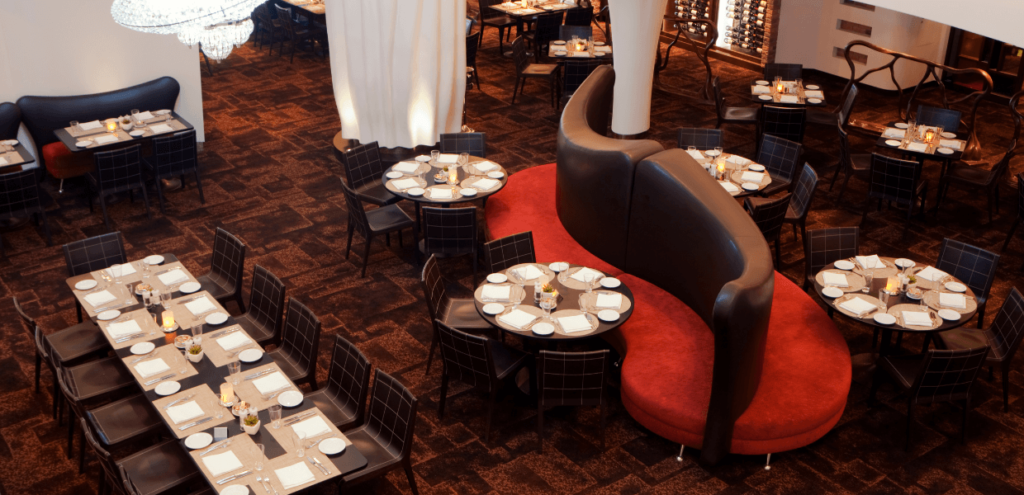All Articles
What Is a Buffet Restaurant

Imagine you are in a spacious room with several tables and chairs. Around you, trays are laden with a variety of foods, from soups to steaks, cheeses, sausages, and baskets of pastries. There’s a coffee machine for making your favorite brew, along with fruit juices and many other delights. Well, you just walked into a buffet restaurant.
This type of restaurant has become increasingly popular for two main reasons: the variety and abundance of food catering to every taste and the convenience for diners who can serve themselves without waiting for a waiter. Whether you’re here to learn more about this restaurant concept because you’re considering opening your own establishment or simply because you’re curious about the restaurant industry, this article will provide valuable insights. First, let’s explore the definition of a buffet restaurant.
How Is a Buffet Restaurant Defined
A buffet restaurant is a dining establishment where food is prepared in advance and served in trays placed on tables or a series of tables. Patrons pay a fixed price and can help themselves to as much as they want from everything available. Unlike family-style restaurants, where bowls and platters of different dishes are brought to the table, buffet customers get up and serve themselves. Buffet restaurants differ significantly even from traditional establishments, where customers order from a menu provided by waiters and wait for their food to be served.
Buffet Restaurants History
Even though the concept of self-service dining can be traced back to ancient cultures, the modern buffet as we know it began to take shape in the 18th century. In France, the term “buffet” originally referred to a sideboard or serving table where dishes were presented. Guests could help themselves from these tables, though the dining style was more informal and less organized than today’s buffets.
In the 19th century, this self-service concept gained popularity, especially in Europe. One of the earliest instances of a buffet-style meal can be seen in the French “buffet chaud,” or hot buffet, which allowed guests to sample a range of hot dishes.
The 20th century saw the buffet concept evolve significantly, especially in the United States. The post-World War II era, focusing on convenience and efficiency, led to the widespread adoption of buffets in American dining culture. The Golden Corral chain, founded in 1973, is a notable example of this trend, popularizing the all-you-can-eat buffet model. An earlier famous European example is the Stockholm Tivoli, which opened in Sweden in 1920.
Buffets have become a staple in various dining establishments, from casual eateries to high-end hotels. They have adapted to include multiple cuisines and dining experiences, reflecting changing tastes and dietary preferences. Innovations like themed buffets, brunch buffets, and international cuisine buffets highlight their versatility and continued popularity.
Characteristics of a Buffet Restaurant
Of course, like any other type of restaurant, buffet restaurants have many characteristics worth discussing. Some can be considered fundamental, while others are secondary. In this section, I will focus on the essentials. Here are what I think are the six most fundamental characteristics of a buffet restaurant:
- Menu

Before discussing the menu at a buffet restaurant, it is worth noting that this dining establishment is famous for every meal of the day. However, each meal is specific to different places that offer a buffet. Breakfast is very popular in hotels or resorts, where people can help themselves with various types of eggs, cheeses, sausages, cereals, milk, pastries, vegetables, and even sweets. Lunch is more attractive in areas near business districts or urban centers, where working people look for a hearty meal during their lunch break. Buffet restaurants are also popular for dinner, providing an enjoyable meal for those who want to dine with friends or family.
Buffet restaurant menus are known to include a variety of international cuisines. Diners can expect to find many comfort food dishes, ranging from Italian pasta to Indian curry, Chinese food, and many others, depending on the operator’s choices. A buffet restaurant typically offers appetizers, soups, salads, main dishes, side dishes, desserts, and both alcoholic and non-alcoholic beverages. The dishes are chicken wings, spring rolls, bruschetta, stuffed mushrooms, shrimp cocktail, Caesar salad, Greek salad, Cobb salad, pasta salad, fruit salad, chicken noodle soup, tomato soup, minestrone, clam chowder, vegetable soup, roast beef, grilled chicken, baked salmon, spaghetti Bolognese, vegetable stir fry, mashed potatoes, steamed vegetables, rice pilaf, macaroni and cheese, roasted Brussels sprouts, chocolate cake, apple pie, cheesecake, ice cream, coffee, tea, soft drinks, juice, water, and many other dishes and beverages.
- Service
Even though the most well-known type of service in a buffet restaurant is self-service, where people get up from the table and serve themselves from the dishes displayed on a buffet line, there are at least three other types.
- Partially Assisted Buffet – In this setup, customers serve themselves specific items while staff assist with others, particularly dishes that require special handling or portion control.
- Station Buffet – Stations are set up around the dining area, each offering a specific type of food, such as a carving station, a seafood station, or a dessert bar.
- Plated Buffet – Guests select from various dishes as they move down the buffet line, but staff serve the choices directly onto plates.
- Building Size

Given that a buffet restaurant needs to accommodate both a dining area with chairs and tables and a space for food display, it is often larger than many other types of restaurants. The need for ample space arises from the high volume of prepared and served food, requiring room for cooking and refilling trays. Consequently, the kitchen in a buffet restaurant is typically larger to support these operational needs.
- Affordability and Pricing
One key factor making buffet restaurants popular, especially among families, is their affordability. Getting a large variety of food for a fixed price is central to their appeal. However, another pricing strategy some buffet restaurants use is weighing the food patrons consume.
Regardless of the chosen pricing model, buffet restaurants are generally known for their affordable prices. Why “generally”? I will delve into this more in the types of restaurants section, but it’s worth noting that some buffet restaurants offer upscale dishes, which are naturally more expensive.
- Atmosphere
As mentioned above, the primary service style in a buffet restaurant is self-service. Guests move to and from the tables to get food, grab a drink, or try different dishes, creating a bustling atmosphere. Nevertheless, proper behavior is expected to ensure a pleasant experience for everyone, so buffet restaurants are not necessarily noisier than other restaurants.
Other words that describe the atmosphere are relaxing and casual. Unlike fine-dining restaurants, where strict etiquette rules are followed, buffet restaurants offer a more familiar and laid-back environment.
- Speed and Convenience
The service at buffet restaurants is as fast as you make it. There’s no need to wait for a waiter to take your order, as you serve yourself, nor do you have to wait for your food to be prepared, as it is already ready and served. This means you can enjoy your meal at your own pace.
Types of Buffet Restaurants
As I suggested earlier, if you thought there was only one type of buffet restaurant, you couldn’t be further from the truth. There are several types of buffet restaurants. Next, I will introduce you to these types and their characteristics.
- All-You-Can-Eat Buffets – These buffets allow patrons to pay a fixed price and enjoy as much food as they want.
- Meal-Period Buffets – These buffets are tailored to specific times of the day, such as breakfast, lunch, or dinner, offering menus that reflect the preferences for each period.
- Cafeteria-Style Buffets – Guests serve themselves from a line of displayed dishes, picking and choosing as they move along. This model is prevalent in institutional settings like schools and corporate cafeterias.
- Healthy Buffet Concepts – With increasing health awareness, these buffets focus on fresh produce, nuts, seeds, and diet-specific options like vegan or gluten-free.
- International Buffets – Offering a diverse range of global cuisines, international buffets allow guests to sample dishes from around the world, from Italian pasta to Japanese sushi and Mexican tacos.
- Ethnic and Regional Buffets – Focusing on specific cultural or regional cuisines, these buffets provide an authentic dining experience highlighting unique flavors and cooking traditions.
- Seasonal Buffets – These buffets feature dishes that showcase fresh, seasonal ingredients and reflect the flavors of the current season.
- Special Occasion Buffets – Designed for events such as Mother’s Day, Easter, and Thanksgiving, these buffets are typically more upscale and feature premium dishes that enhance the festive spirit.
- Luxury Buffets – Elevating the buffet experience with high-end offerings like seafood towers, prime cuts of meat, and exotic desserts, luxury buffets are typically found in upscale hotels and restaurants. They are priced higher, reflecting premium food quality and a sophisticated ambiance.
- Catered Buffets – Often seen at events, conferences, or weddings, catered buffets offer a buffet-style service in a more controlled, service-oriented environment.
- Barbecue Buffets – Perfect for meat lovers, barbecue buffets allow diners to grill various marinated meats at their table. This interactive and enjoyable setup lets guests cook their food to their liking, creating a convivial atmosphere and providing fresh, hot meals.
- Dessert Buffets – Centered around sweet treats, dessert buffets offer a variety of pastries, cakes, chocolates, and more. They are famous for special occasions like weddings and parties.
- Conveyor Belt Sushi – Known as kaiten-zushi, conveyor belt sushi offers an engaging dining experience where sushi plates move on a rotating belt past the dining area. Diners select their desired plates as they pass by, allowing for efficient service and reduced food waste.
Advantages and Disadvantages of Buffet Restaurants

As with any type of restaurant, buffet restaurants have advantages and disadvantages. The table below considers these aspects from both the restaurant owners’ and the customers’ perspectives.
| Advantages | Disadvantages |
| People have a variety of food to choose from | Overeating |
| Affordable for customers | Food wastage |
| Appealing to groups with diverse dietary preferences | Potentially lower food quality due to focus on quantity |
| Reduced need for personnel | Lower profitability for restaurant |
| Well-managed food costs | Investment required in equipment to keep food at the right temperature |
| Standardized and quicker preparation time | Quailiy can decrease due to the need to keep food warm for an extended period |
| More people get their food immediately | Potential for mess and spilled food |
| It may not appeal to those who prefer à la carte dining |
Buffet Restaurants Health and Safety Regulations
Due to the shared use of utensils, cross-contamination can be a significant issue in buffet restaurants. To address this, buffet restaurants must adhere strictly to health and safety regulations. Ideally, they should provide sufficient utensils to allow for regular replacement. Additionally, disinfectants should be made available for customers to use before handling utensils, and patrons should be encouraged to use them.
Buffet restaurants should also ensure food and ingredients are maintained at appropriate temperatures to prevent spoilage. Furthermore, maintaining a clean environment throughout the building is essential for upholding food safety and hygiene standards.
The Cost to Start a Buffet Restaurant
The estimated cost to open a restaurant is around $275,000 for a leased space and $425,000 for a purchased location. However, several factors specific to buffet restaurants can influence these costs. The layout required for buffet service may increase building expenses. Conversely, buffet restaurants generally require less personnel both in the kitchen, due to bulk food preparation, and for service.
Here are the factors to consider when calculating your final cost:
- Space and Layout: Ensure sufficient space for a comfortable buffet setup. Plan the layout to facilitate smooth guest flow and consider incorporating separate stations for different types of food.
- Equipment and Supplies: Assess the need for additional equipment such as chafing dishes, serving utensils, plates, and glasses. Include the costs of purchasing or renting these items in your budget.
- Food Cost: Calculate the cost of ingredients for each buffet item, considering portion sizes and potential wastage.
- Labor Cost: Determine the staffing requirements for buffet setup, replenishment, and clearing. Factor in the time needed for preparation and cleaning.
- Pricing Strategy: Set the price per person for the buffet based on your food and labor costs, desired profit margin, and local market competition. Consider offering different pricing options for adults, children, and seniors.
- Food Waste Management: Implement strategies to minimize food waste, such as careful portioning, monitoring guest preferences, and properly storing and repurposing leftovers.
- Promotion and Marketing: Develop marketing strategies to attract customers, including local media advertising, leveraging social media, or partnering with nearby businesses for joint promotions.
Tips for Maximizing Profit in a Buffet Restaurant
Prospective owners might initially find the concept of a buffet restaurant, particularly an all-you-can-eat buffet, daunting. With the promise of unlimited food for a fixed price, it’s natural to wonder how such a restaurant can be profitable. Two key aspects to consider are how buffet restaurants reduce costs compared to other dining establishments and strategies for increasing profitability.
Buffet restaurants can cut costs in three main areas. First, they minimize expenses related to front-of-house staff. Unlike traditional restaurants, buffets do not require servers to serve food; staff primarily focus on cleaning tables and refilling trays as needed. Second, in the back-of-house, food is prepared in bulk, eliminating the need for detailed plating and reducing costs. Additionally, the bulk preparation of food helps cut overall food costs, contributing to the restaurant’s cost-efficiency.
To enhance profitability, consider implementing the following strategies:
- Separate Beverage Pricing: Exclude beverages from the fixed price for food. Charging separately for drinks can increase revenue from customers who wish to have beverages with their meal. You may also adjust the pricing for beverages to boost overall profits further.
- Smaller Plates and Silverware: Use smaller plates and utensils to encourage customers to take less food at a time. This can help them feel full more quickly, leading to reduced overall food consumption.
- Smaller Food Trays: Serve food in smaller trays and containers. This approach can make customers more mindful of their portions and reduce waste. Ensure your staff regularly monitors and refills these trays to avoid leaving customers without options.
- Menu Item Tracking: Monitor which menu items are most and least popular. Based on this data, adjust refilling practices to minimize food waste.
Conclusion
As we have explored, buffet restaurants offer a unique dining experience. In this article, we have delved into their history, the factors contributing to their popularity—namely, the abundant food at an affordable price—and their distinctive characteristics. We have also reviewed the different types of buffet restaurants, their advantages and disadvantages, health and safety regulations, strategies for enhancing profitability, and considerations related to opening costs.
If this article has helped you discover new helpful information about buffet restaurants, do not hesitate to share it with your friends.
 5 August 2024
5 August 2024 9 min read
9 min read

